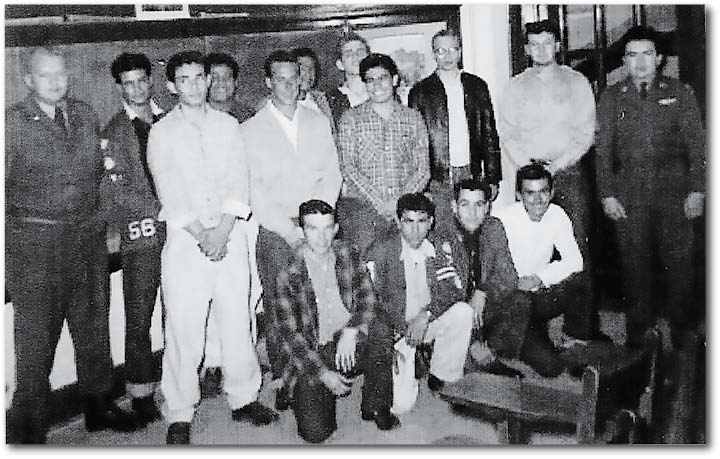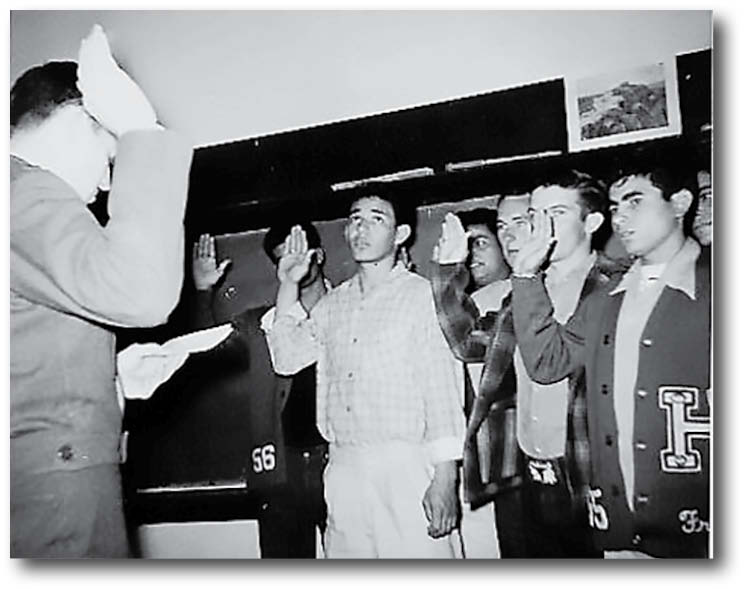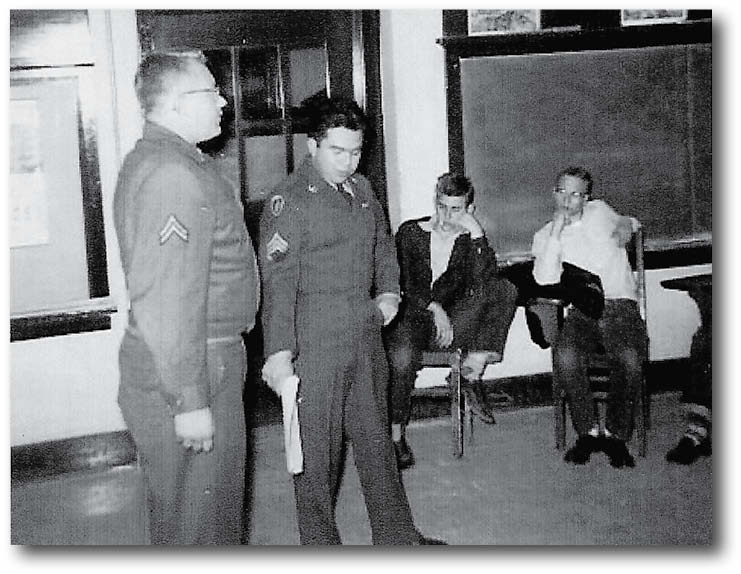
Swearing in ceremonies at Hayden High School marked the beginning of a detached Army Reserve training unit in Hayden. Commanding Officer Lt. Dale Collier performed the rites that included 13 new enlistees in the organization. From left to right above are: Collier, Pat Dorsey, Norman Miller, Alfonso Santos, Frank Bravo, Frank Martinez, Edmund Romero, Joe Rodriguez, Frank Rodriguez, Donald Holcomb, Frank Cruz and Charlie Poarch. Not pictured taking the oath is Gregorio M. Arbizo. Other members of the new group are Collier’s brother, Lt. Robert O. Collier, Sgt. Walter C. Romero and Ronald Griffith, also Cpl. John L. Sharrah and Sgt. Bacilo J. Cabazos of Mammoth. Present for the ceremonies was M/Sgt. Renneav of the USAR Advisor Group of the Tucson Military District.

Company Commander, 1st Lt. Dale E. Collier swears in 13 recruits. The photo was taken in the Old Hayden High School classroom.

Sgt. Romero demonstrates proper military stances assisted by Cpl. Sharrah. Photo was taken in the Old Hayden High School Classroom.
Special to the Nugget
I write this story of the Army Reserve Unit assigned to Hayden Junction, Ariz., for its historic value to the citizens of the Copper Basin Area. The history of the copper mining area from San Manuel to Superior is steeped in events that are recorded only in the memory of those who lived them. I feel it a shame that more of the “old timers” have failed to record those experiences to pass down to future generations.
A little known bit of the Copper Basin area history, is that there was once a Army Reserve Unit based at Hayden Junction, Ariz.
To provide a little background, the unit was formed by two of the local railroad employees, Robert and Dale Collier, brothers who both were employed by the Southern Pacific Railroad, at Hayden Junction.
Robert Collier graduated from Gila Bend High School in the spring of 1941. He moved from Gila Bend, to Tucson, where he began an apprenticeship with the Southern Pacific Railroad, as a machinist. When World War II broke out in December of 1941, it was the patriotic thing to enlist in the service of our country. In February of 1942, Robert, and several of his fellow railroad employees enlisted in the Navy, along with several other good young men in the Tucson area. He served in the Pacific theater on repair ships and landing craft. He obtained the grade of second class petty officer, motor mechanic. When he was discharged at the end of hostilities, he returned to his railroad apprenticeship and received his papers as a Railroad Machinist. He continued to work in the Tucson round house in that capacity. As with all discharged service men of the day, he was required to complete at least two years of time in the Naval Reserve. He served in the Naval Reserve group assigned to the Tucson area.
I graduated from the eighth grade in Gila Bend, in 1941, the same year as my older brother Bob graduated from high school. Being too young to join the services, I continued my education and graduated from Gila Bend High School in 1945. Of course, the first thing that I attempted to do was to join the service. This endeavor was unsuccessful because I wore glasses and my attempts to enlist were rejected by four separate service organizations. I then secured a job with the Southern Pacific Railroad in Gila Bend, as a machinist helper. All was well, until in August of 1946, I was married and set up housekeeping with M. Jeanne (Star) Collier.
Things were progressing as “planned”, and along comes Uncle Sam’s draft, and said, “Greetings, Dale E. Collier, you are to report to Phoenix, for physical examination, you have been drafted." Of course, I figured, that since I have been turned down before, that I would be rejected. However, the doctors said I was fit as a fiddle, and I was shipped out to Camp Beale, Calif., in early October of 1946. Of course the United States Army cannot do anything simple. They kept the entire unit at Camp Beale for a short period, then shipped us across the country to Fort Bragg, North Carolina for basic training. Because of Army regulations, thinning out the services from excess personal, that were in effect at the time, I received an honorable discharge and returned to my civilian occupation.
In 1949, after working in Gila Bend as a Machinist Helper, a vacancy in the electrical department of the Tucson shops came up, and I was able to obtain an electrical apprenticeship. As times were tough financially for young apprentices, my brother Robert suggested that I join the Naval Reserve to enhance my pay check. This was a four year commitment, which I was more than willing to do. However, fate and the times, once again changed the course I was to follow. The Southern Pacific Railroad had been in transition from steam to diesel motive power. Two of the eight electrical apprentices were selected to be upgraded to the status of “Electrician”. I was one of those selected. In July of 1950, I was offered a job at Hayden Junction. A job that required that I maintain diesel locomotives that serviced the mining operations in that area. I accepted the job, as I felt that the remote area had more to offer than the Tucson Round House.
In 1952, the Southern Pacific Railroad sponsored a “Railway Shop Battalion “. At the time, Reserve officer, Lt. Col. Sam Gillespie, was the assistant superintendent of maintenance at Tucson, Ariz. He was given the command of the newly formed, “754th Railway Shop Battalion”. His job was to organize, staff, and train a unit capable of taking the field as a functional unit on short notice.
Col. Gillespie interviewed and selected men within his own maintenance organization to head up the Battalion. He filled all the Officer slots and sent his recommendations forward to the department of the Army for commissions. Robert Collier received his commission as a second lieutenant and started training at the Army Reserve Post in Tucson.
In 1952 the Southern Pacific Railroad laid off a great many employees from their Tucson shops. The transition from steam locomotives, to diesel, was in its final stages, and there was no longer need for large maintenance forces in the shops.
Brother Robert applied for and was granted a transfer from Tucson, to Hayden Junction, where there was an opening for a machinist to work maintenance on the diesel locomotives.
I had received my journeyman papers as a railroad electrician in 1953. Brother "Bob " and I worked side by side in the Hayden Junction shop. I had also received my discharge from the Naval Reserve. As I moved too far to attend weekly sessions, I was put on the inactive list when I moved from Tucson to Hayden Junction in July of 1950.
Brother Bob, was having to travel from Hayden Junction to Tucson to attend weekly meetings of the Battalion, headquartered in Tucson. It was at this time, that he found out that a vacancy had occurred in the officer staff of the battalion. He relayed this information, to me, and after a discussion, I decided to apply for that vacancy. I completed the necessary paper work, and was called up for an interview with Major Gillespie. To my surprise, he was satisfied with what he saw, and put me in for a direct appointment in the Army Reserve. It came through in a couple of months, and I was commissioned a first Lt. in the Army Reserve.
The Colonel called me to confirm this appointment, and asked to speak to my brother. As Bob later relayed to me, the Major could not apologize to him enough. Bob was my older brother and when he was commissioned, it was as a second Lt. Now, because of the only opening available at the time, I was promoted over my older brother, who was in the unit first. (He was a most understanding brother, and was pleased that I was able to get into the Battalion with him.) I’m not so sure, that if I were the older brother, I could have been so understanding.
Bob and I traveled for several months every week to the Tucson Armory, where we were busy with organizational matters and advanced schooling. I was assigned as Headquarters Company Commander, and Bob was my executive officer.
We were busy filling all the vacancies in the enlisted ranks and setting up special MOS schooling for those individuals. This reserve group, was what was termed, "Cadre". The Battalion would select, enlist, and train those who would be the nucleus in case of activation. Our classes and administrative duties took five to six hours every evening that we trained. Add the hour and a half each way that we had to travel from Hayden Junction to Tucson, it made for a very long and trying day. However, it was one of the most enjoyable times that we had spent together. Bob was four years older than me, so as children, we did not spend that much time together.
During this time period after the Second World War, the military had regulations regarding enlisted and drafted people. Army regulations required all who served to be assigned to a reserve unit upon their discharge from active duty. The Korean war was winding down, and many enlisted, as well as officers were being assigned to reserve units near their home towns. This was a great source of personnel for active reverse units. Ours was no exception. We were able to fill our "Cadre" requirements without too much trouble. However, being a specialized Railway Shop unit, it was necessary for us to place those unrated non-con's and train them for those slots.
It was during our working hours at the Hayden Junction round house, that we became acquainted with a young man still in high school. His name was John Sharrah, and he was dating a young lady who lived in Hayden Junction with her parents. When John was not courting, he would come by the round house and talk with us, and he became interested in the Army Reserve. After John graduated from high school, he joined our Army Reserve unit, and traveled back and forth to Tucson with us for training. This was the first step in organizing the Hayden detachment of the 754th Railway Shop Battalion.
Bob and I had talked about the possibility of a Company in Hayden Junction, and discussed it with the Battalion commander. He was very receptive to the idea, and gave us the green light to go forward. Company “A” of the Battalion was officially moved to the Hayden Junction, when we obtained enough recruits to satisfy the ARs. (Army Regulations)
We needed the cooperation of the local community, so we started with the Hayden High School Superintendent Maurice Gemmell. He was very receptive and even provided classrooms and a meeting place in the old high school building located in the center of Hayden. His open door policy gave us a great deal of assistance in recruiting from the senior class, a great deal of whom would turn eighteen, just before, or shortly after their graduation from high school. After the initial enlistment, we still needed a place to meet. Once again, the high school superintendent came through for us. He gave us permission to use the basement of the high school to meet in. This was not to be our permanent home, but sure served the purpose at the time.
The Army had initiated a program, that made several options available to the new recruits. One was a six year enlistment, with two years of active duty plus one year of active reserve, and three years of inactive duty. Another was a six year enlistment, with six months of active duty, three years of active reserve, and the balance on inactive duty. There were a couple other combinations, but they were not the most popular. During this time, as the draft was still in effect, most wanted to avoid that program. We were able to sell the six months of active duty program. One of our biggest selling points was that we were a support group and the skills that we taught were applicable to civilian life after service.
Staff Sergeant Walter C. Romero, who had recently returned from Korea was the first inactive NCO to join our unit. He was the ranking NCO for quite some time. He was a great help in establishing the training for the new recruits. PFC John Sharrah, had been promoted to corporal, and between them, they took care of the initial instructions to the recruits.
As we were unable to secure a meeting place, we continued to meet under the old high school. After some discussion brother Bob and myself came up with an idea to solve our problem. We put a request in to Battalion Headquarters for a couple of retired passenger cars that we could put on the siding at Hayden Junction. The Battalion Commander, having an “in” with the Southern Pacific Railroad, (the Southern Pacific Railroad was the civilian sponsor of the unit) secured an old passenger and one old baggage car.
We took the seats out in the passenger car and converted it to classrooms. We then started holding our meetings at Hayden Junction. This, of course, was with the assistance of the entire unit. We set up an office for the first. Sgt., and an office in the old baggage car for the officers to work out of. I do remember one incident that stands out in my memory. We were installing the steel cage within the baggage car, and we had to anchor it to the floor. Those old baggage cars, were very well built, and had solid oak flooring. The steel frame for the cage, was bored to accommodate anchor bolts. In my haste to position the frame on the floor, I tried to drive a nail into the oak. Bad idea. I was successful in hitting my thumb with the hammer, and later losing my left thumb nail.
We also converted the old baggage car to a supply and warehouse for the company equipment. As anyone knows, everything that we did, was governed by ARs (Army Regulations). Every well equipped company headquarters were required to have the many volumes available on the shelf. We were required to constantly study them and update them and review them with the troops.
Security of Uncle Sam’s property was of the utmost concern of the regular Army advisors. As we had many weapons, as well as all our other equipment, it was incumbent upon us to place weapon under triple lock and key. M1 Garands, M1 carbines, and .45 Cal. automatics were the principle weapons assigned to our unit. The rifles all had to be not only stored in a locked building, but inside a locked steel mesh cage. Then, placed in a locked “Rifle Rack”. The hand guns, were also stored in a like manner, however, we had an Army issue safe that we kept them in, inside the cage. We were also provided with, .22 cal. conversion kits, to facilitate practice that was less expensive than using the .45 cal. ammunition. We were issued a couple of heavy barrel, .22 cal. rifles for the purpose of training.
We were required by ARs, to familiarize all the troops with the cal. 30 machine gun, and the BAR. (Browning Automatic Rifle). These were the main support weapons for the battalion.
As we were required to meet on a weekly basis, we were able to accomplish quite a bit in a very short period of time. We spent half of our time teaching required military subjects, and the other half on special training. We took the men into the Hayden Junction Shop and made them familiar with the working tools. The lathes, drill presses, welding equipment, both elect and acetylene. The work around a railroad shop, requires the special trades such as machinist, electricians, boilermakers, pipe fitters, welders, carpenters, and painters, to name a few. Any and every type of work that you can imagine has to have a person trained to perform their respective duties.
We were required to provide the training for equipment operators, such as cranes, fork lifts, trucks, and pile drivers once again to name a few.
About the Author:Dale Collier came to Hayden Junction with the Southern Pacific Railroad. When the Railroad Co. left the area, he chose not to go to California, but opted to go to work for Kennecott Company, and also began his law enforcement venture, first as Constable for the area, then, when Kearny was built, he became their first Law enforcement Officer. He continued working for Kennecott too. Later he was appointed Kearny Town Magistrate where he served for more than 40 years. He and his wife have retired to Apache Junction.

